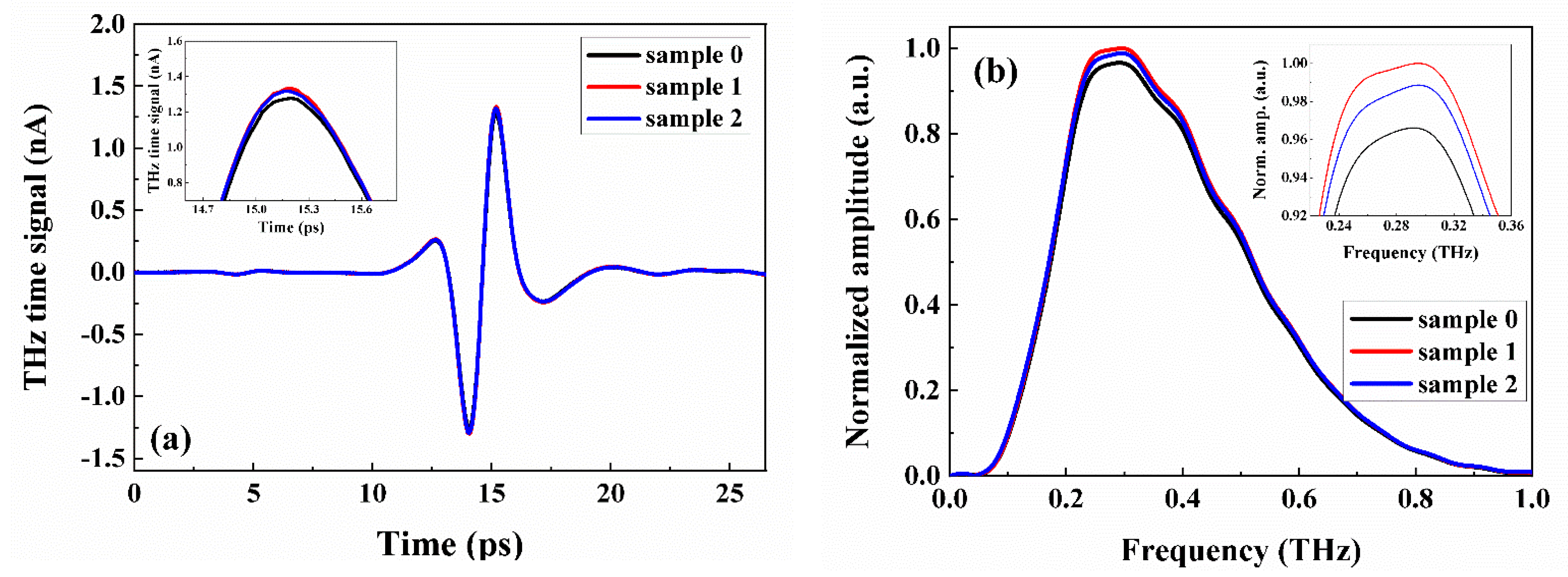Terahertz Emission and Ultrafast Carrier Dynamics of Ar-Ion Implanted Cu(In,Ga)Se2 Thin Films
Abstract
:1. Introduction
2. Materials and Methods
3. Results
4. Conclusions
Author Contributions
Funding
Conflicts of Interest
References
- Dabbabi, S.; Bennasr, T.; Kamoun, N.T. CIGS Solar Cells for Space Applications: Numerical Simulation of the Effect of Traps Created by High-Energy Electron and Proton Irradiation on the Performance of Solar Cells. JOM J. Miner. Met. Mater. Soc. 2019, 71, 602–607. [Google Scholar] [CrossRef]
- Otte, K.; Makhova, L.; Braun, A.; Konovalov, I. Flexible Cu(In,Ga)Se2 thin-film solar cells for space application. Thin Solid Films 2006, 511–512, 613–622. [Google Scholar] [CrossRef]
- Jasenek, A.; Schock, H.W.; Werner, J.H.; Rau, U. Defect annealing in Cu(In,Ga)Se2 heterojunction solar cells after high energy electron irradiation. Appl. Phys. Lett. 2001, 79, 2922. [Google Scholar] [CrossRef]
- Jasenek, A.; Rau, U. Defect generation in Cu(In,Ga)Se2 heterojunction solar cells by high-energy electron and proton irradiation. J. Appl. Phys. 2001, 90, 650. [Google Scholar] [CrossRef]
- Green, M.A.; Dunlop, E.D.; Hohl-Ebinger, J.; Yoshita, M.; Kopidakis, N.; Hao, X. Solar cell efficiency tables (version 56). Prog. Photovoltaics Res. Appl. 2020, 28, 629–638. [Google Scholar] [CrossRef]
- Mayer, J.W. Ion Implantation Semiconductors; Californian Institution of Technology: Pasadena, CA, USA, 1998. [Google Scholar]
- Larson, L.A.; Williams, J.M.; Michael, I. Current, Ion Implantation for Semiconductor Doping and Materials Modification. Rev. Accel. Sci. Technol. 2011, 4, 11–40. [Google Scholar] [CrossRef]
- Lee, S.H.; Choi, M.; Kim, T.T.; Lee, S.; Liu, M.; Yin, X.; Choi, H.K.; Lee, S.S.; Choi, C.-G.; Zhang, X.X.; et al. Switching terahertz waves with gate-controlled active graphene metamaterials. Nat. Mater. 2012, 11, 936–941. [Google Scholar] [CrossRef] [PubMed] [Green Version]
- Yoo, H.K.; Yoon, Y.; Lee, K.; Kang, C.; Kee, C.-S.; Hwang, I.-W.; Lee, J.W. Highly efficient terahertz wave modulators by photo-excitation of organics/silicon bilayers. Appl. Phys. Lett. 2014, 105, 011115. [Google Scholar] [CrossRef]
- Lee, W.J.; Ma, J.W.; Bae, J.M.; Jeong, K.S.; Cho, M.H.; Kang, C.; Wi, J.S. Strongly Enhanced THz Emission caused by Localized Surface Charges in Semiconducting Germanium Nanowires. Sci. Rep. 2013, 3, 1984. [Google Scholar] [CrossRef] [PubMed] [Green Version]
- Němec, H.; Pashkin, A.; Kužel, P.; Khazan, M.; Schnüll, S.; Wilke, I. Carrier dynamics in low-temperature grown GaAs studied by terahertz emission spectroscopy. J. Appl. Phys. 2001, 90, 1303. [Google Scholar] [CrossRef] [Green Version]
- George, P.A.; Strait, J.; Dawlaty, J.; Shivaraman, S.; Chandrashekhar, M.; Rana, F.; Spencer, M.G. Ultrafast Optical-Pump Terahertz-Probe Spectroscopy of the Carrier Relaxation and Recombination Dynamics in Epitaxial Graphene. Nano Lett. 2008, 8, 4248. [Google Scholar] [CrossRef] [PubMed] [Green Version]
- Averitt, R.D.; Rodriguez, G.; Siders, J.L.W.; Trugman, S.A.; Taylor, A.J. Conductivity artifacts in optical-pump THz-probe measurements of YBa2Cu3O7. J. Opt. Soc. Am. B Opt. Phys. 2000, 17, 327–331. [Google Scholar] [CrossRef]
- Lee, W.-J.; Cho, D.-H.; Wi, J.-H.; Han, W.S.; Chung, Y.-D.; Park, J.; Bae, J.M.; Cho, M.-H. Na-Dependent Ultrafast Carrier Dynamics of CdS/Cu(In,Ga)Se2 Measured by Optical Pump-Terahertz Probe Spectroscopy. J. Phys. Chem. C 2015, 119, 20231–20236. [Google Scholar] [CrossRef]
- Lee, W.-J.; Yu, H.-J.; Wi, J.-H.; Cho, D.-H.; Han, W.S.; Yoo, J.; Yi, Y.; Song, J.-H.; Chung, Y.-D. Behavior of Photocarriers in the Light-Induced Metastable State in the p-n Heterojunction of a Cu(In,Ga)Se2 Solar Cell with CBD-ZnS Buffer Layer. ACS Appl. Mater. Interfaces 2016, 8, 22151–22158. [Google Scholar] [CrossRef] [PubMed]
- Lee, W.-J.; Cho, D.-H.; Wi, J.-H.; Yu, H.-J.; Han, W.S.; Bae, J.M.; Park, J.; Chung, Y.-D. Ultrafast Photocarrier Dynamics at the p–n Junction in Cu(In,Ga)Se2 Solar Cell with Various Zn(O,S) Buffer Layers Measured by Optical Pump–Terahertz Probe Spectroscopy. ACS Appl. Energy Mater. 2018, 1, 522–530. [Google Scholar] [CrossRef]
- Lee, W.-J.; Lee, G.; Cho, D.-H.; Chul, K.; Myoung, N.; Kee, C.S.; Chung, Y.-D. Ultrafast Photoexcited-Carrier Behavior Induced by Hydrogen Ion Irradiation of a Cu(In,Ga)Se2 Thin Film in the Terahertz Region. IEEE Trans. Terahertz Sci. Technol. Early Access 2021. [Google Scholar] [CrossRef]
- Chung, Y.-D.; Cho, D.-H.; Han, W.-S.; Park, N.-M.; Lee, K.-S.; Kim, J. Incorporation of Cu in Cu(In,Ga)Se2-based Thin-film Solar Cells. J. Korean Phys. Soc. 2010, 57, 1826–1830. [Google Scholar] [CrossRef]
- Sakai, K. THz Optoelectronics, Topics in Applied Physics; Springer: Berlin/Heidelberg, Germany, 2005; Chapter 3. [Google Scholar]
- Liu, X.; Yu, H.; Ji, Q.; Gao, Z.; Ge, S.; Qiu, J.; Liu, Z.; Zhang, Y.; Sun, D. An ultrafast terahertz probe of the transient evolution of the charged and neutral phase of photo-excited electron-hole gas in a monolayer semiconductor. 2D Mater. 2016, 3, 014001. [Google Scholar] [CrossRef] [Green Version]
- Lee, W.-J.; Cho, D.-H.; Bae, J.M.; Kim, M.E.; Park, J.h.; Chung, Y.-D. Ultrafast wavelength-dependent carrier dynamics related to metastable defects in Cu(In,Ga)Se2 solar cells with chemically deposited Zn(O,S) buffer layer. Nano Energy 2020, 74, 104855. [Google Scholar] [CrossRef]
- Kushnir, K.; Wang, M.; Fitzgerald, P.D.; Koski, K.J.; Titova, L.V. Ultrafast zero-bias photocurrent in GeS nanosheets: Promise for photovoltaics. ACS Energy Lett. 2017, 2, 1429–1434. [Google Scholar] [CrossRef]




| Sample 0 | Sample 1 | Sample 2 | |
|---|---|---|---|
| τ1 | 9.90 | 38.43 | 59.44 |
| τ2 | 1569.22 | 328.45 | 414.44 |
Publisher’s Note: MDPI stays neutral with regard to jurisdictional claims in published maps and institutional affiliations. |
© 2021 by the authors. Licensee MDPI, Basel, Switzerland. This article is an open access article distributed under the terms and conditions of the Creative Commons Attribution (CC BY) license (https://creativecommons.org/licenses/by/4.0/).
Share and Cite
Kang, C.; Lee, G.; Lee, W.-J.; Cho, D.-H.; Maeng, I.; Chung, Y.-D.; Kee, C.-S. Terahertz Emission and Ultrafast Carrier Dynamics of Ar-Ion Implanted Cu(In,Ga)Se2 Thin Films. Crystals 2021, 11, 411. https://doi.org/10.3390/cryst11040411
Kang C, Lee G, Lee W-J, Cho D-H, Maeng I, Chung Y-D, Kee C-S. Terahertz Emission and Ultrafast Carrier Dynamics of Ar-Ion Implanted Cu(In,Ga)Se2 Thin Films. Crystals. 2021; 11(4):411. https://doi.org/10.3390/cryst11040411
Chicago/Turabian StyleKang, Chul, Gyuseok Lee, Woo-Jung Lee, Dae-Hyung Cho, Inhee Maeng, Yong-Duck Chung, and Chul-Sik Kee. 2021. "Terahertz Emission and Ultrafast Carrier Dynamics of Ar-Ion Implanted Cu(In,Ga)Se2 Thin Films" Crystals 11, no. 4: 411. https://doi.org/10.3390/cryst11040411







